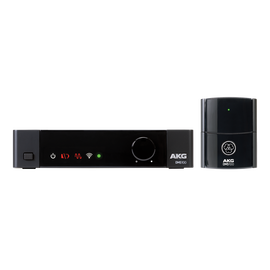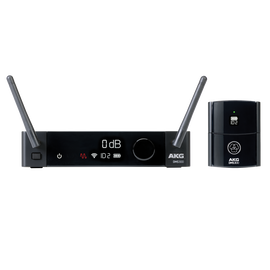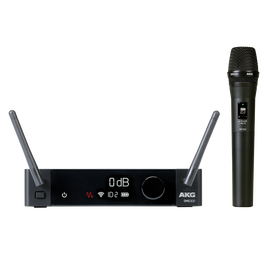
AKG Blog
Comparing digital & analog wireless mic systems
By Sarah jones
What’s been holding you back from making the leap to a wireless system? Think you have to worry about poor sound quality, signal dropouts and unreliability? Think again. These days, great wireless systems can sound as good as—or even better than—wired systems, and they’re more reliable than ever. They’re critical tools in modern productions, from concerts to theatre events to houses of worship to corporate presentations. Journalists, vloggers, videographers and fitness instructors rely on wireless systems every day, and it’s not uncommon for today’s biggest tours, Broadway shows and sports events to manage dozens or even hundreds of wireless channels.
The benefits of wireless are obvious: freedom of movement, less cable clutter and a low profile. But with the wealth of options out there, from simple analog systems to complex, multi-channel digital operations, choosing the right system—and getting it to work—can feel daunting.
Since the release of AKG’s new DMS 100 and DMS 300 digital wireless systems, we’ve fielded lots of questions about the differences between digital and analog systems, so we thought it would be helpful to explain the benefits of each.

WIRELESS 101
First, let’s look at how wireless systems work. (For the purpose of this discussion, we’re talking about wireless systems in the context of live situations.)
You probably already know that wired microphones convert sound waves into an electrical signal, which is sent over a cable into a sound system. Wireless systems convert those sound waves into a radio signal, which is then transmitted to a receiver, which converts the signal back and sends it into a sound system.
Every wireless system includes three components:
- • The microphone (or instrument input): Varieties include handheld, headset and lavalier mics, clip-on instrument mics and guitar and bass input systems.
- • The transmitter: This converts the audio signal into RF and broadcasts it through the airwaves to a receiver. Transmitters are built into microphones and clip-on belt packs.
- • The receiver: Here, the RF signal is converted back to an electrical audio signal, where it enters the sound system. Receivers connect to your sound system, and can take the form of rack-mount or standalone boxes.
- • Analog systems use companding to compress the signal transmitted from the microphone and expand it again at the receiver. This process maximizes the audio signal’s dynamic range and minimizes noise; however it can introduce artifacts such as “pumping” and “breathing.”
- • Digital systems, on the other hand, encode sound as a digital signal—zeroes and ones—that modulate a radio carrier signal, which is then sent over the air and picked up by a receiver, where that signal is converted back to sound.

Infographic illustrating how a digital wireless microphone system works.
Let’s dig a little deeper into some key considerations when choosing a system, and compare how digital and analog systems fare.
ANALOG VERSUS DIGITAL
Wireless systems convert analog audio into a radio signal and back through either analog or digital processes. It’s hard to make a straight comparison between digital and analog systems—you’ll need to factor in quality of components, features, your budget and intended application. But all things equal, there are fundamental differences.
SOUND QUALITY
First things, first: Fidelity starts at your sound source. When choosing a microphone, make sure it sounds great, can handle high SPLs, and is robust enough to withstand stage use.
Digital systems generally offer better audio quality than analog systems, for a couple of reasons: Audio is converted to a high-resolution (often 24-bit/48kHz) digital signal, and that signal is devoid of analog artifacts (like those introduced by companding) and interference. (However the best analog systems can rival digital in terms of dynamic range and resistance to interference.)

LATENCY
Latency, the time delay between signal input and output in a system, is a big deal when you’re performing live. Analog systems, by design, have virtually no latency. Early digital technologies had unacceptably high latency, which was introduced by the process of converting analog to digital and back again. Most modern digital systems have overcome those limitations; AKG’s new DMS 100 and DMS 300 systems, for example, have an extremely low latency of 2.9 ms—far below the threshold of perception.
EASE OF OPERATION
There are a couple of things to understand about setting up wireless systems—and these are true whether you choose a digital or analog system: Your transmitter and receiver must operate on the same frequency, and two wireless systems in the same location can’t operate on the same frequency.
Fortunately, your system can handle this process for you. AKG’s new DMS 100 and DMS 300 wireless systems, for example, are plug-and-play simple: Channel pairing happens seamlessly in the background; set your receiver to seeking mode and you’re ready to go.
Longer battery life will give you greater peace of mind; here, digital systems often win out because they use lower-power transmitters. The AKG DMS 100 and 300, for example, offer 12 hours of battery life. (The DMS 300 also features a high-res display that will keep you informed of channel status, signal strength battery levels, and other functions at a glance.)

SECURITY
Corporate and government communications call for confidentiality, and if you’re concerned about protecting sensitive information, than digital systems are the way to go. Unlike analog signals, digital signals can be encrypted; for example, AKG DMS 100 and DMS 300 digital wireless systems feature robust, secure 256-bit AES encryption. If privacy is important, digital encryption is the only way to ensure that nobody but your audience is able to hear your presentation.
LICENSING AND THE FCC
In the U.S., the FCC allows wireless systems to operate in dedicated radio frequency bands, on both a licensed and unlicensed basis. Wireless systems share these bands with other technologies, such as television and radio broadcast and cellular services. But that bandwidth is finite, and as the FCC auctions off spectrum to major wireless service providers, less spectrum is being made available for analog wireless microphone and instrument systems. There’s a lot to unpack regarding the FCC auction (you can read all about it on the FCC website), but the key takeaway is, since digital wireless systems like the AKG DMS 100 and 300 operate in the 2.4GHz space, which is a global, license-free standard, those systems have not been adversely impacted the way analog systems have.
SO, WHO BENEFITS FROM WIRELESS SYSTEMS?
The answer is simple: Anyone who wants the freedom that comes with removing the limitations of cables and cords.
- • Musicians can choose single or multi-channel systems to accommodate their entire group.
- • Presenters engage audiences better when they’re not stuck behind the podium.
- • Fitness instructors have unencumbered, hands-free range of movement.
- • Journalists and content creators enjoy untethered freedom on location.
- • Small businesses can take advantage of security offered by digital systems.
Once you cut the cord, you’ll open up a whole new world of performance possibilities. Explore AKG’s range of digital and analog wireless systems that fit any application and budget.
Still not convinced that wireless is the way to go? Check out this demo video that includes the new DMS 300 to see just how simple it is to set up and operate:

Related products
AKG Blogs
9 pro tips for livestreaming your show from home
If you’re like most musicians, gigs are your lifeblood. But when you can’t connect with your audience in person, livestreaming is your best opportunity to gain new fans and generate income while building momentum for your next show.
Read MoreHow to Pick Professional Headphones for Any Scenario
What’s your most-used piece of audio gear? You probably don’t need us to tell you that it’s your headphones. Headphones provide a consistent audio reference in a variety of environments, they’re essential tools for evaluating the fine details in your mix—and they do it without annoying the neighbors.
Read MoreComparing digital & analog wireless mic systems
Since the release of AKG’s new DMS 100 and DMS 300 digital wireless systems, we’ve fielded lots of questions about the differences between digital and analog systems, so we thought it would be helpful to explain the benefits of each.
Read MoreHow to choose the right microphone to record anything
Choosing the right mic is more art than science, and involves trial and error. Getting to know the “sound” of the mics you own and learning how they perform in different scenarios are the first steps toward making professional-sounding recordings at home.
Read MorePro sound for work-at-home professionals
Whether your home office or classroom is temporary or permanent, HARMAN has affordable, easy-to-use tools that will help you communicate with clarity and focus on the task at hand.
Read More7 ways to sound better on a conference call
Conferencing services like Zoom, Skype and Webex bring familiar faces right to your screen—and chances are, conference calls are becoming a central part of your life right now.
Read MoreHow to get studio-quality sound from your smartphone with AKG Lyra
Whether you’re recording a podcast or voiceover, making field recordings, capturing audio inspiration on the go, or live streaming to your fans, nothing beats the convenience and portability of a smartphone.
Read MoreAKG DMS300 Digital Wireless Systems Earn High Praise from Performer Magazine
Wireless microphone systems have come a long way over the years, and the AKG DMS300 digital system is no exception. Once thought of as inferior to their wired counterparts, many wireless systems like DMS300 not only sound just as good—if not better—than wired systems.
Read More










